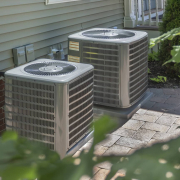How to Reset a Water Heater
You know how cold it gets here in Chicago in the winter. It is frigid for all of winter and it takes every ounce of us to get out from the nice warm bed when the alarm goes off to jump into the shower. If you are like many people, you turn the water on and let it warm up before jumping in. However, what if you are standing there waiting and the water is NOT warming up?
Every thought goes through your head about what could be wrong on this cold Monday morning. It could be the water heater reset button tripped. How do you reset a water heater? Check the electrical panel and flip the button to on (if it was in the off position and vice versa). Then, push the red reset button on the water heater. If those don’t work, you will need to call a professional.
Let’s take a look at why this is important, checking the electrical panel, the purpose of the reset button, what to do if it does not come back on, maintenance of the water heater, and when to call a professional.
Why This is Important
It is important that you have hot water coming out of the faucets, appliances, and showerheads. The warm water is not only for showers but to properly clean clothes and dishes. Water heaters last about 8-12 years but sometimes need replacing before that.
Why Water Heaters Stop Working
Often the water heater reset button trips because something is faulty on the water heater or issues such as:
- The water heater unit’s thermostat is not working.
- The reset button is malfunctioning.
- The high-limit switch is not working- that is the part that keeps the water from getting too hot. If it trips, then there is a problem with it or it is allowing the water to get to hot.
- There is a short in the heating element- this may allow the water to continue to heat up, however, it will trip the high-limit switch.
- A wire is loose somewhere in the water heater- this can cause the water to get hot and trip the high-limit switch.
- An electrical issue in the home.

Check the Electrical Panel
Wander over to the electrical panel. It is often in the garage, basement, or storage closet. There is a circuit breaker that is labeled “Water heater.”
If the breaker is in the “off” position, flip it to “on.” If it stays “on”, even after a few minutes, it was a minor issue and all seems to be well.
If it goes off, follow the directions below. However, if the breaker is in the “on” position, flip it to “off.”
Purpose of the Water Heater Reset Button
The purpose of this button is to stop the flow of power from the water heater. This is a safety feature and happens when there is an issue in the water heater such as a thermostat not working properly or a power surge. The reset button keeps the water from getting too hot in the unit.

Water Heater Reset Button: Location and How to Reset It
The reset button is often red and located near the thermostat or behind a metal panel that is removable on the unit. When you find it, push the reset button and then release it.
There may be a lower thermostat button also known as a second reset button. Push this and then release it. Does the water heater trip again right away after pushing either button? Then there is an issue with a part and you will need to call a professional.
If it does not trip, replace the metal panel on the unit and go to the electrical box and flip the circuit breaker back to the “on” position. Does the water heater turn on? Yes? This is great!
If it does not turn on, switch the breaker back to “off” and call a professional.
Possible Reason The Water Heater Won’t Work
In a water heater unit, there is an upper and lower heating unit. If the thermometer is not working correctly, the water can become scalding hot as mentioned above. Thus, the reset button will trip to keep the water from coming out, as this is not normal.

How a Water Heater Works
The water fills in the bottom of the tank and the lower thermostat heats the water up. As the water travels up the tank, the upper heating element continues to keep the water hot in the unit.
When the water sits in the tank, it cools down. Then, when the water is needed, the thermostats heat it up. There is a temperature on the high limit thermostat in the upper heating element and when the water heats to that temperature, the thermostat shuts off.
Lower Heating Element
If the lower heating element or thermostat in that area stops working, then the cold water goes up to the upper heating level. When the water comes out in whichever appliance you are using or in the shower, the cold water is what will come out. This is because it did not heat up on its travels to the top.
Upper Heating Element
If this part stops working and the lower heating element works, you may get hot water for a little bit. However, it will turn cold once it starts pulling the water from the upper element. It will be cold because there is no continuous heating element at the top working to keep it from getting cold. The high limit switch will trip as the water continues to heat up in the higher element to avoid it coming out scalding hot.

Maintenance of a Water Heater
As with all appliances, you may be able to find this issue early if you properly maintain the unit.
Here are a few ideas:
- Flush the hot water heater
- Whether you have gas or electric, adjust the temperature and reset
- Turn your gas water heater off and back on
- When you are traveling, set the water heater to vacation mode
- Tighten the drain valve if you see water leaking out
- Check the temperature release valve, also known as T&P or TPR
- Set thermostat to 120 degrees F.

Check the Anode Rod in a Tank Style Water Heater
Inside a tank-style water heater is an anode rod. This keeps the middle of the tank from rusting. Changing this out as it starts to rust will keep the water heater working longer. How do you know if the anode rod is bad? There is a rusty smell, a sulfur smell, brown or rusty water, a gel-like substance, or the water heater is leaking or making noise. If your water heater is 5 years old, it is time to change the rod.
Check the Age of a Water Heater
Not sure when the water heater was last replaced? You can find out the age of a water heater by the label on the unit. Usually, the last two digits of the year are listed on the serial number. However, if you have a Bradford water heater, it is a little more difficult to find it.
Replacing a Water Heater
There are a lot of things to think about when replacing the water heater if it comes down to that point. The style of heater, the tank size, etc. Take a look at this article to see what might work best for you!
When to Call a Professional
Call a professional if your water heater is tripping or not working at all. There also could be an issue with appliances sharing a circuit breaker and you want to make sure this is not the case. A professional can let you know if there is life left in your water heater or if you need to replace it. Additionally, if you need your water tested, it is a good idea to call a professional to make sure it is safe to drink.
Conclusion
Water heaters are essential in our lives as we use hot water for showers and our appliances to make sure they are clean. When they are working properly, they can last 8-12 years. If your water heater is having issues, check out the steps above and call a professional if you need assistance. Hopefully, it is a minor issue with the reset button and you can fix it. We will inspect your water heater during our home inspections in Chicago.
Questions about your water heater or in need of our services? Comment below.











Comments are closed.